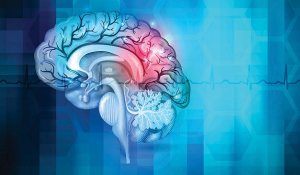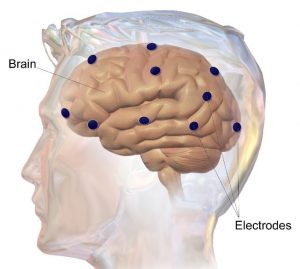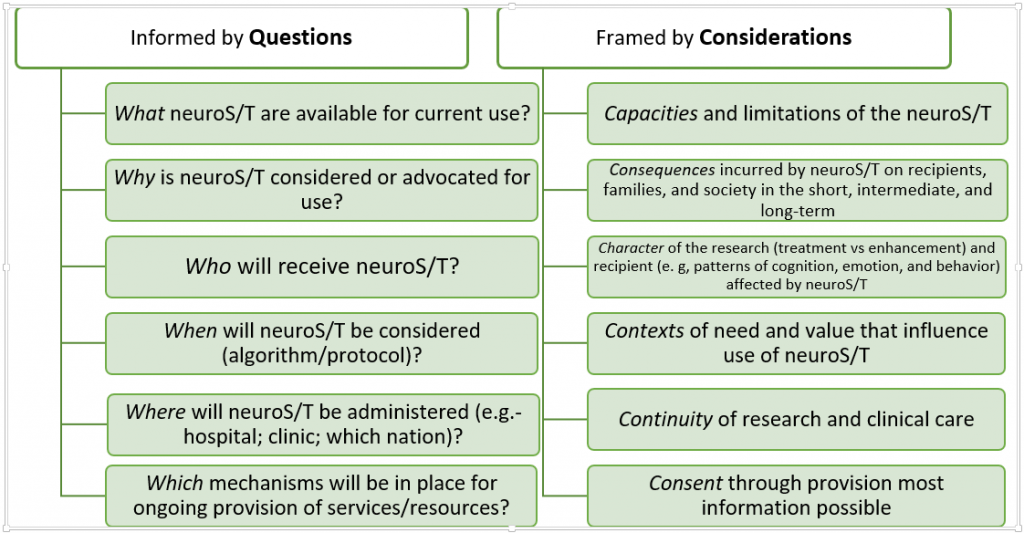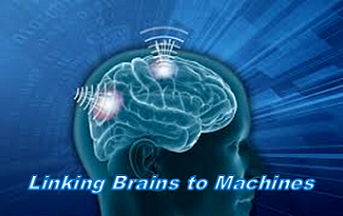[Editor’s Note: In today’s post, returning guest bloggers Mr. Joseph DeFranco and Dr. James Giordano examine the ramifications of Neuralink moving forward with Brain-Machine Interfaces, posing five tough questions on what the crossing of this neuroscience frontier means from medical, ethical, legal, and geo-political perspectives. Read their compelling post — will “neuro-modified human actors be considered weaponized biological agents?”]
On July 16th, Elon Musk announced that his company Neuralink will move to advance clinical translation of a novel brain-machine interface (BMI) that he claims holds “…promise for the restoration of sensory and motor function and the treatment of neurological disorders.” 1 Although the company’s efforts to develop such a BMI has only been underway for 28 months,2 it has already created an innovative, functioning application in an in vivo rat model. Musk  seeks to begin clinical trials in 2020 for treatment of particular neurological disorders. Musk also asserts that this technology could and should be available to any individual who wishes to achieve “better access” and “better connections” to “the world, each other, and ourselves.”3
seeks to begin clinical trials in 2020 for treatment of particular neurological disorders. Musk also asserts that this technology could and should be available to any individual who wishes to achieve “better access” and “better connections” to “the world, each other, and ourselves.”3
The BMI involves implantation of microelectrodes (as many as 3,072 per array) to record neurological activity in the brain. These electrodes convey signals to sensors that can be detected by an external device (e.g., a smart phone).4 The intricacies and complex nature of the brain’s neural architecture and vasculature demand precision of the implantation procedure, and to this end Neuralink will employ a newly developed robotic system for inserting the electrodes. This system will be monitored and managed by a neurosurgeon who can manually adjust the robotic system as needed during the procedure.
Indubitably, this emerging technology is noteworthy and could foster understanding and treatments of a number of neuro-psychiatric conditions. Yet, there are several questions that we believe must be addressed and answered before Neuralink – or any related technology – is offered and made available to the public.
First, who will receive this BMI? Presentations by Musk assert that a main goal is to make the procedure “… as simple and automated as LASIK”.5 We also advocate the importance of, and need for safe and reliable procedures; in this light, it should be borne in mind that the methods described require  neurosurgical intervention to insert the electrodes. And although the level of invasiveness may be reduced, and perhaps increasingly minimized with iterative developments of technology and protocols, inherent neurosurgical risks (e.g., intracranial bleeding; infection) must be recognized. It may well be that the relative benefit-to-burden / risk calculus may support the use of a novel procedure if and when other, extant, and prior interventions are ineffective. Still, we advocate that any such consideration should appreciate and engage questions and contingencies relative to mitigating risks (see Table 1). To wit, what conditions will be treated using this approach; or perhaps more specifically, which patients will receive such treatments?
neurosurgical intervention to insert the electrodes. And although the level of invasiveness may be reduced, and perhaps increasingly minimized with iterative developments of technology and protocols, inherent neurosurgical risks (e.g., intracranial bleeding; infection) must be recognized. It may well be that the relative benefit-to-burden / risk calculus may support the use of a novel procedure if and when other, extant, and prior interventions are ineffective. Still, we advocate that any such consideration should appreciate and engage questions and contingencies relative to mitigating risks (see Table 1). To wit, what conditions will be treated using this approach; or perhaps more specifically, which patients will receive such treatments?
Table 1: Preparatory Neuroethics Paradigms 6, 7

Second, who will perform this procedure and where will it take place? And, if Musk’s invitation to any individual who seeks “better access” and “better connections” to “the world, each other, and ourselves” is indicative of a broader interest in, and market for receiving this BMI technology, the question of “who will receive the interventions” becomes even more pressing. Given current attitudes (in the United States, Europe, Japan, and Australia) regarding medical interventions intended for “non-therapeutic” (i.e., optimization / enhancement) purposes,8 will surgeons in these countries be amenable to implanting the Neuralink BMI for such ends? If not, then we query where these procedures might be provided. Further, we ask how (and to what extent) these procedures will be funded.
Third, if, as Musk has stated this technology is to remain implanted and function for “years to decades” (and possibly a “lifetime”), will – and where will – ongoing research be performed to prospectively assess the benefit, burdens and/or harms incurred?9
 Fourth, given this proposed durability, it is likely that: (1) newer versions of the technology will be developed; and (2) older versions of the technology will require maintenance and updating. Therefore, we ask if and how issues and problems of obsolescence will be addressed and resolved?10 Will (and how will) device maintenance and upgrades be covered under some remunerative plan (e.g., insurance; corporate sponsorship)?
Fourth, given this proposed durability, it is likely that: (1) newer versions of the technology will be developed; and (2) older versions of the technology will require maintenance and updating. Therefore, we ask if and how issues and problems of obsolescence will be addressed and resolved?10 Will (and how will) device maintenance and upgrades be covered under some remunerative plan (e.g., insurance; corporate sponsorship)?
Fifth; as this technology becomes available to the public, will there be a time when the majority of a society has a BMI? If this were to occur, what about the minority who don’t? Or, if only a select few can acquire a BMI, how will society regard and treat these individuals? Here, scenarios such as that posed in Daniel Wilson’s novel, Amped, come to the fore.11 And what of the gap between the neuro-capabilized “haves” and those who “have not”? Such questions should not be limited to concerns about intranational distributive justice: What does the use of this technology portend for the schism between developed, developing, and un-developed nations?
 We applaud Neuralink’s strivings to develop cutting-edged therapeutics and respect their view toward neurological optimization. These developments prompt – if not mandate – recognition and acknowledgment of varying cultural needs, values, philosophies, and ethics, as each and all influence receptivity to this and other forms of BMI research and uses-in-practice.12 Some nations, based upon their views, ethos, and ethics, may be more willing, if not eager to provide this technology to their citizens, and possibly to Warfare, Intelligence, and National Security (WINS) personnel.13
We applaud Neuralink’s strivings to develop cutting-edged therapeutics and respect their view toward neurological optimization. These developments prompt – if not mandate – recognition and acknowledgment of varying cultural needs, values, philosophies, and ethics, as each and all influence receptivity to this and other forms of BMI research and uses-in-practice.12 Some nations, based upon their views, ethos, and ethics, may be more willing, if not eager to provide this technology to their citizens, and possibly to Warfare, Intelligence, and National Security (WINS) personnel.13
At present, BMIs are not addressed by the Biological and Toxin Weapons Convention. However, if Neuralink-type BMIs, and other neurotechnologies14 are used to augment WINS operators, it begs the question of whether neuro-modified human actors should be considered “weaponized biological agents?”15 And if so, how should they be regarded and treated (both during their tenure in service, and afterward)?
To be sure, neurotechnology is rapidly advancing toward ever greater capabilities. Will global civic (and WINS) institutions remain apace?16 Given the distinctions in the socio-cultural and political values, aims, and ethics that shape research and its applications, what discourses and dialectic will be needed – or accepted – to guide, govern, and constrain acting with such haste, so as to avoid repenting in leisure? As we are fond of saying – and as every neurosurgeon knows well – it is wisest to “measure twice; cut once” whether opening a skull, a vista of new capabilities and possibilities, or a can of worms.
If you enjoyed this post, please also see:
China’s Brain Trust: Will the U.S. Have the Nerve to Compete? by Mr. Joseph DeFranco, CAPT (USN – Ret.) L. R. Bremseth , and Dr. James Giordano
Neuroscience and the Weapons of War podcast, with Dr. Giordano
Connected Warfare by COL James K. Greer (USA-Ret.)
Sine Pari by Mr. Howard R. Simkin
Author Biographies:
Joseph DeFranco is J5 Donovan Group Fellow in Biowarfare and Biosecurity, at U.S. Special Operations Command (USSOCOM). He is currently studying neuroscience in the College of Arts and Sciences, and biodefense at the Schar School of Policy and Government of George Mason University, VA, and formerly served on the staff of Congressman Donald S. Beyer (VA-08). His current research focuses upon the possible use of novel microbiological agents and big data as force-multiplying elements in non-kinetic, hybrid, and kinetic engagements, and the role of global agencies in biosecurity.
Mad Scientist James Giordano, PhD, is Professor of Neurology and Biochemistry, Chief of the Neuroethics Studies Program, and Co-Director of the O’Neill-Pellegrino Program in Brain Science and Global Law and Policy at Georgetown University Medical Center. He currently serves as J5 Donovan Group Senior Fellow, Biowarfare and Biosecurity, U.S. Special Operations Command (USSOCOM), and as an appointed member of the Neuroethics, Legal, and Social Issues (NELSI) Advisory Panel of the Defense Advanced Research Projects Agency (DARPA). Previously, Dr. Giordano served as Senior Science Advisory Fellow of the Strategic Multilayer Assessment Group of the Joint Staff of the Pentagon; and was Senior Research Fellow and Task Leader for the EU Human Brain Project Subproject on Dual Use Brain Science.
Disclaimer: The views expressed in this blog are those of the authors, and do not necessarily reflect those of the Department of Defense, U.S. Special Operations Command, the Defense Advanced Research Projects Agency (DARPA), Department of the Army, Army Futures Command (AFC), or Training and Doctrine Command (TRADOC).
Acknowledgments: This blog was adapted from the authors’ forthcoming work appearing in the Philosophy, Ethics and Humanities in Medicine. JG is supported by funding from CSCI and Leadership Initiatives.
References:
1 Musk E. An integrated brain-machine interface platform with thousands of channels. bioRxiv, 703801 (2019).
2 Winkler R. Elon Musk Launches Neuralink to Connect Brains with Computers. (2017, March 27). Retrieved from https://www.wsj.com/articles/elon-musk-launches-neuralink-to-connect-brains-with-computers-1490642652
3 CNET. (2019, July 17). Watch Elon Musk’s Neuralink presentation. Retrieved from https://www.youtube.com/watch?v=lA77zsJ31nA; accessed 24. July, 2019.
4 Ibid. ref. 2.
5 Ibid. ref. 3.
6 Giordano J. Toward an operational neuroethical risk analysis and mitigation paradigm for emerging neuroscience and technology (neuroS/T). Exp Neurol 287 (4): 492-495 (2017).
7 Giordano J. A preparatory neuroethical approach to assessing developments in neurotechnology. AMA J Ethics 17(1): 56-61 (2015).
8 For overviews, see:
Jotterand F, Dubljevic V. (eds.) Cognitive Enhancement: Ethical and Policy Implications in International Perspectives. Oxford: Oxford University Press, 2016.
Berger TW, Glanzman DL. (eds.) Toward Replacement Parts for the Brain: Implantable Biomimetic Electronics as Neural Prostheses. Cambridge MA: MIT Press, 2005.
9 Giordano J. Conditions for consent to the use of neurotechnology: A preparatory neuroethical approach to risk assessment and reduction. AJOB-Neuroscience 6(4): 12-14 (2015).
10 Shook JR, Giordano J. Neuroethics beyond normal: Performance enablement and self-transformative technologies. Cambridge Quarterly of Healthcare Ethics 25.1 (2016): 121-140 (2016).
11 Wilson DH. Amped. NY: Doubleday, 2012.
12 For more information, see:
Shook JR, Giordano J. A principled, cosmopolitan neuroethics: Considerations for international relevance. Phil Ethics Humanities in Med 9 (1); (2014).
Lanzilao E, Shook, J, Benedikter R, Giordano J. Advancing neuroscience on the 21st century world stage: The need for – and proposed structure of – an internationally relevant neuroethics. Ethics Biol Engineer Med 4(3): 211-229 (2013).
13 Palchik G, Chen C, Giordano J. Monkey business? Development, influence and ethics of potentially dual-use brain science on the world stage. Neuroethics, 10:1-4 (2017).
14 Giordano J, Wurzman, R. Neurotechnology as weapons in national intelligence and defense. Synesis: A Journal of Science, Technology, Ethics and Policy, 2, 138-151 (2011).
15 Liivoja R, Chircop, L. Are enhanced warfighters weapons, means, or methods of warfare? International Law Studies, 94(1), 7 (2018).
16 Shook JR, Giordano J. Moral bioenhancement for social welfare: Are civic institutions ready? Front Sociol 2(21): 1-5 (2017).



